Corporate governance and Regulatory Processes Assignment PDF
VerifiedAdded on 2021/05/30
|9
|2502
|89
AI Summary
Contribute Materials
Your contribution can guide someone’s learning journey. Share your
documents today.

Running Head: CORPORATE GOVERNANCE AND REGULATORY PROCESSES 0
corporate governance and regulatory processes
MAY 18, 2018
STUDENT DETAILS:
corporate governance and regulatory processes
MAY 18, 2018
STUDENT DETAILS:
Secure Best Marks with AI Grader
Need help grading? Try our AI Grader for instant feedback on your assignments.
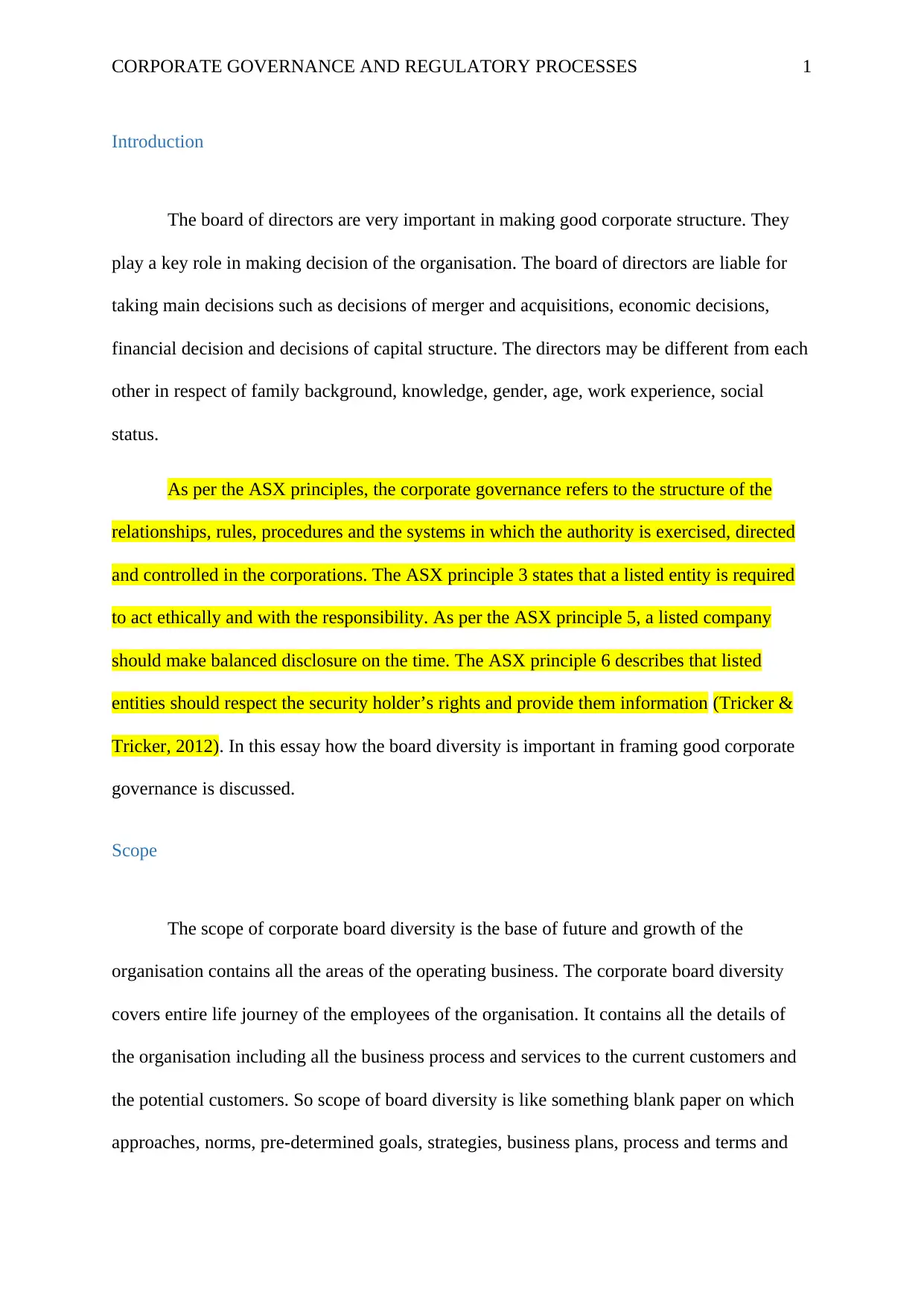
CORPORATE GOVERNANCE AND REGULATORY PROCESSES 1
Introduction
The board of directors are very important in making good corporate structure. They
play a key role in making decision of the organisation. The board of directors are liable for
taking main decisions such as decisions of merger and acquisitions, economic decisions,
financial decision and decisions of capital structure. The directors may be different from each
other in respect of family background, knowledge, gender, age, work experience, social
status.
As per the ASX principles, the corporate governance refers to the structure of the
relationships, rules, procedures and the systems in which the authority is exercised, directed
and controlled in the corporations. The ASX principle 3 states that a listed entity is required
to act ethically and with the responsibility. As per the ASX principle 5, a listed company
should make balanced disclosure on the time. The ASX principle 6 describes that listed
entities should respect the security holder’s rights and provide them information (Tricker &
Tricker, 2012). In this essay how the board diversity is important in framing good corporate
governance is discussed.
Scope
The scope of corporate board diversity is the base of future and growth of the
organisation contains all the areas of the operating business. The corporate board diversity
covers entire life journey of the employees of the organisation. It contains all the details of
the organisation including all the business process and services to the current customers and
the potential customers. So scope of board diversity is like something blank paper on which
approaches, norms, pre-determined goals, strategies, business plans, process and terms and
Introduction
The board of directors are very important in making good corporate structure. They
play a key role in making decision of the organisation. The board of directors are liable for
taking main decisions such as decisions of merger and acquisitions, economic decisions,
financial decision and decisions of capital structure. The directors may be different from each
other in respect of family background, knowledge, gender, age, work experience, social
status.
As per the ASX principles, the corporate governance refers to the structure of the
relationships, rules, procedures and the systems in which the authority is exercised, directed
and controlled in the corporations. The ASX principle 3 states that a listed entity is required
to act ethically and with the responsibility. As per the ASX principle 5, a listed company
should make balanced disclosure on the time. The ASX principle 6 describes that listed
entities should respect the security holder’s rights and provide them information (Tricker &
Tricker, 2012). In this essay how the board diversity is important in framing good corporate
governance is discussed.
Scope
The scope of corporate board diversity is the base of future and growth of the
organisation contains all the areas of the operating business. The corporate board diversity
covers entire life journey of the employees of the organisation. It contains all the details of
the organisation including all the business process and services to the current customers and
the potential customers. So scope of board diversity is like something blank paper on which
approaches, norms, pre-determined goals, strategies, business plans, process and terms and
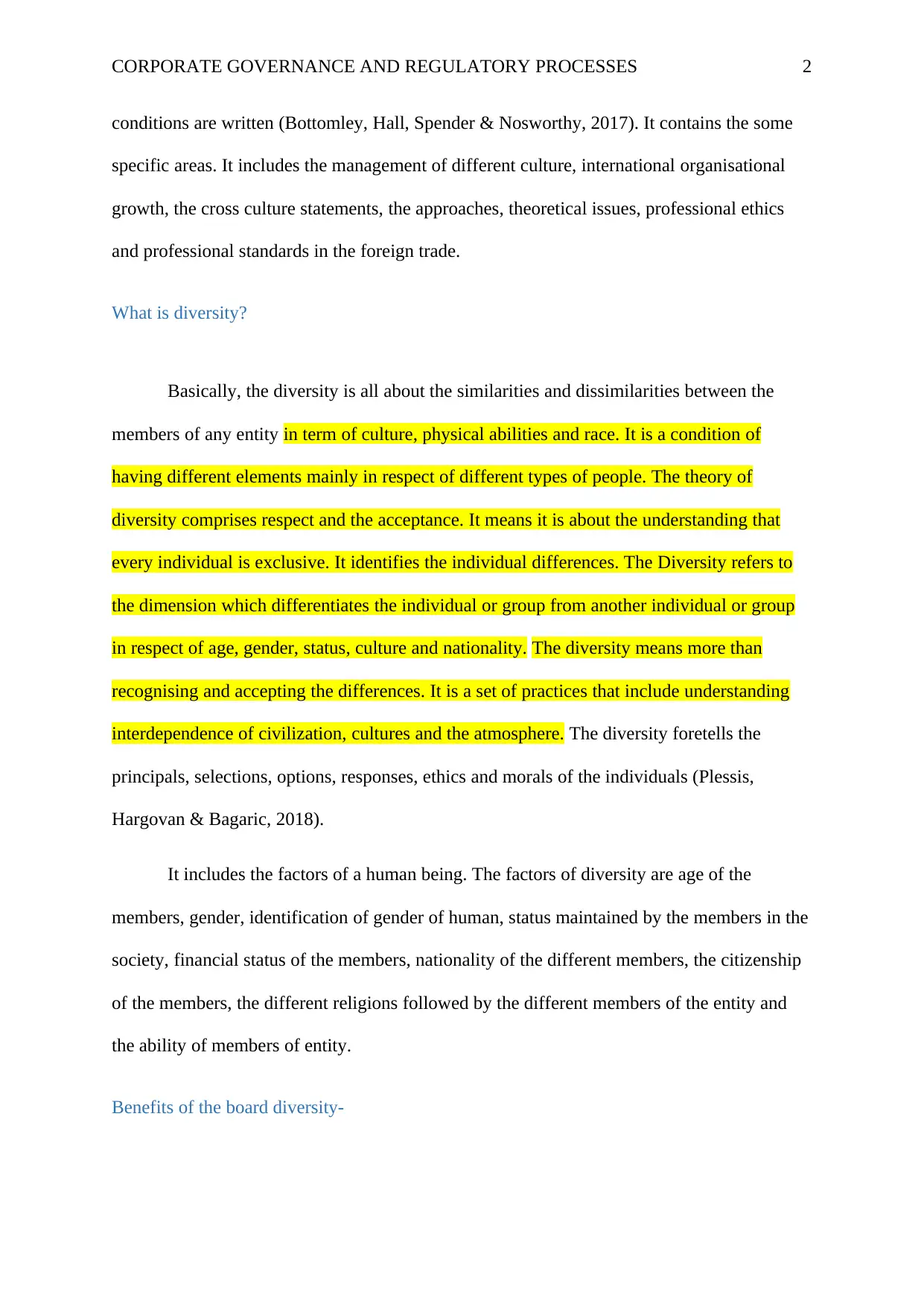
CORPORATE GOVERNANCE AND REGULATORY PROCESSES 2
conditions are written (Bottomley, Hall, Spender & Nosworthy, 2017). It contains the some
specific areas. It includes the management of different culture, international organisational
growth, the cross culture statements, the approaches, theoretical issues, professional ethics
and professional standards in the foreign trade.
What is diversity?
Basically, the diversity is all about the similarities and dissimilarities between the
members of any entity in term of culture, physical abilities and race. It is a condition of
having different elements mainly in respect of different types of people. The theory of
diversity comprises respect and the acceptance. It means it is about the understanding that
every individual is exclusive. It identifies the individual differences. The Diversity refers to
the dimension which differentiates the individual or group from another individual or group
in respect of age, gender, status, culture and nationality. The diversity means more than
recognising and accepting the differences. It is a set of practices that include understanding
interdependence of civilization, cultures and the atmosphere. The diversity foretells the
principals, selections, options, responses, ethics and morals of the individuals (Plessis,
Hargovan & Bagaric, 2018).
It includes the factors of a human being. The factors of diversity are age of the
members, gender, identification of gender of human, status maintained by the members in the
society, financial status of the members, nationality of the different members, the citizenship
of the members, the different religions followed by the different members of the entity and
the ability of members of entity.
Benefits of the board diversity-
conditions are written (Bottomley, Hall, Spender & Nosworthy, 2017). It contains the some
specific areas. It includes the management of different culture, international organisational
growth, the cross culture statements, the approaches, theoretical issues, professional ethics
and professional standards in the foreign trade.
What is diversity?
Basically, the diversity is all about the similarities and dissimilarities between the
members of any entity in term of culture, physical abilities and race. It is a condition of
having different elements mainly in respect of different types of people. The theory of
diversity comprises respect and the acceptance. It means it is about the understanding that
every individual is exclusive. It identifies the individual differences. The Diversity refers to
the dimension which differentiates the individual or group from another individual or group
in respect of age, gender, status, culture and nationality. The diversity means more than
recognising and accepting the differences. It is a set of practices that include understanding
interdependence of civilization, cultures and the atmosphere. The diversity foretells the
principals, selections, options, responses, ethics and morals of the individuals (Plessis,
Hargovan & Bagaric, 2018).
It includes the factors of a human being. The factors of diversity are age of the
members, gender, identification of gender of human, status maintained by the members in the
society, financial status of the members, nationality of the different members, the citizenship
of the members, the different religions followed by the different members of the entity and
the ability of members of entity.
Benefits of the board diversity-
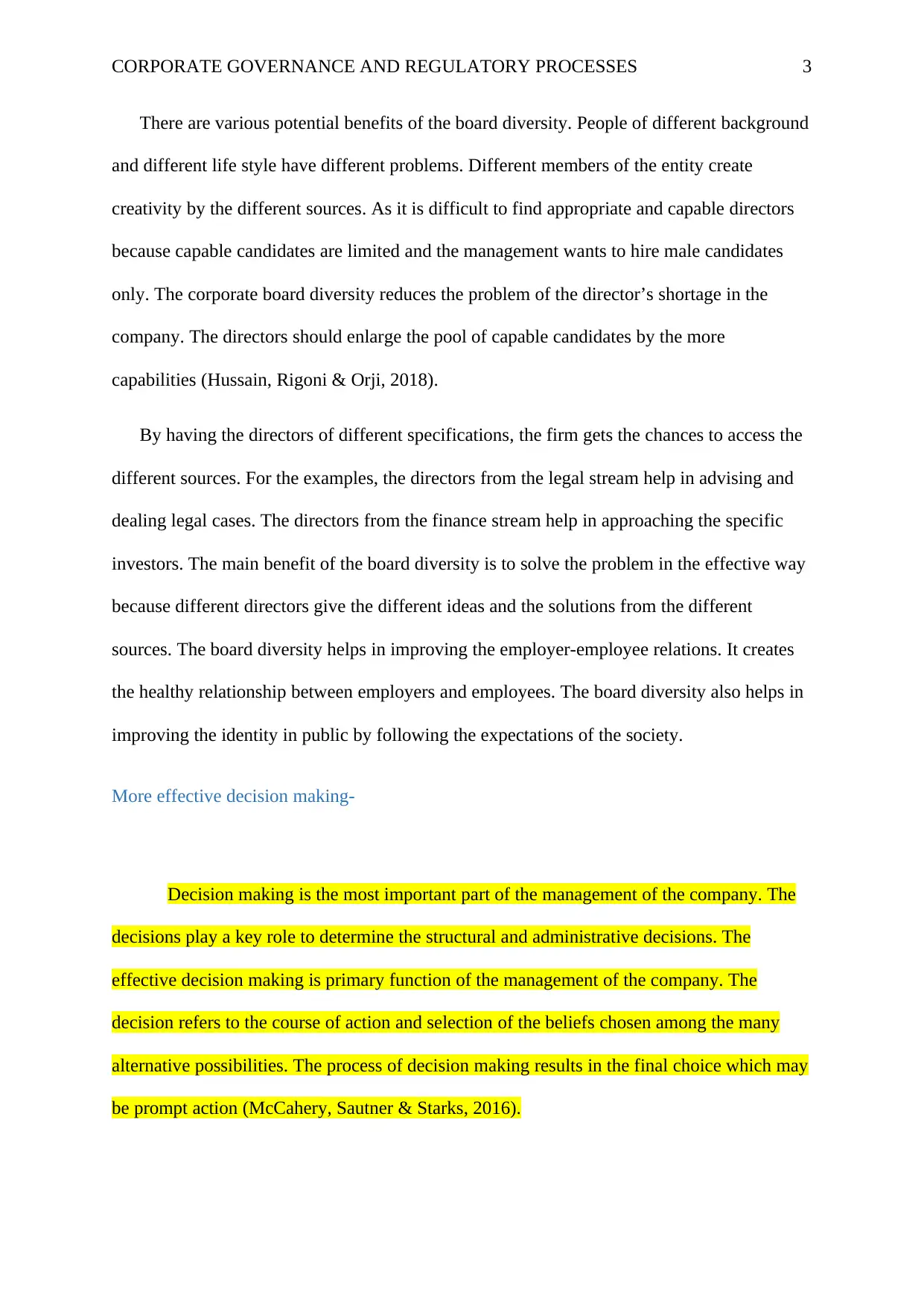
CORPORATE GOVERNANCE AND REGULATORY PROCESSES 3
There are various potential benefits of the board diversity. People of different background
and different life style have different problems. Different members of the entity create
creativity by the different sources. As it is difficult to find appropriate and capable directors
because capable candidates are limited and the management wants to hire male candidates
only. The corporate board diversity reduces the problem of the director’s shortage in the
company. The directors should enlarge the pool of capable candidates by the more
capabilities (Hussain, Rigoni & Orji, 2018).
By having the directors of different specifications, the firm gets the chances to access the
different sources. For the examples, the directors from the legal stream help in advising and
dealing legal cases. The directors from the finance stream help in approaching the specific
investors. The main benefit of the board diversity is to solve the problem in the effective way
because different directors give the different ideas and the solutions from the different
sources. The board diversity helps in improving the employer-employee relations. It creates
the healthy relationship between employers and employees. The board diversity also helps in
improving the identity in public by following the expectations of the society.
More effective decision making-
Decision making is the most important part of the management of the company. The
decisions play a key role to determine the structural and administrative decisions. The
effective decision making is primary function of the management of the company. The
decision refers to the course of action and selection of the beliefs chosen among the many
alternative possibilities. The process of decision making results in the final choice which may
be prompt action (McCahery, Sautner & Starks, 2016).
There are various potential benefits of the board diversity. People of different background
and different life style have different problems. Different members of the entity create
creativity by the different sources. As it is difficult to find appropriate and capable directors
because capable candidates are limited and the management wants to hire male candidates
only. The corporate board diversity reduces the problem of the director’s shortage in the
company. The directors should enlarge the pool of capable candidates by the more
capabilities (Hussain, Rigoni & Orji, 2018).
By having the directors of different specifications, the firm gets the chances to access the
different sources. For the examples, the directors from the legal stream help in advising and
dealing legal cases. The directors from the finance stream help in approaching the specific
investors. The main benefit of the board diversity is to solve the problem in the effective way
because different directors give the different ideas and the solutions from the different
sources. The board diversity helps in improving the employer-employee relations. It creates
the healthy relationship between employers and employees. The board diversity also helps in
improving the identity in public by following the expectations of the society.
More effective decision making-
Decision making is the most important part of the management of the company. The
decisions play a key role to determine the structural and administrative decisions. The
effective decision making is primary function of the management of the company. The
decision refers to the course of action and selection of the beliefs chosen among the many
alternative possibilities. The process of decision making results in the final choice which may
be prompt action (McCahery, Sautner & Starks, 2016).
Secure Best Marks with AI Grader
Need help grading? Try our AI Grader for instant feedback on your assignments.
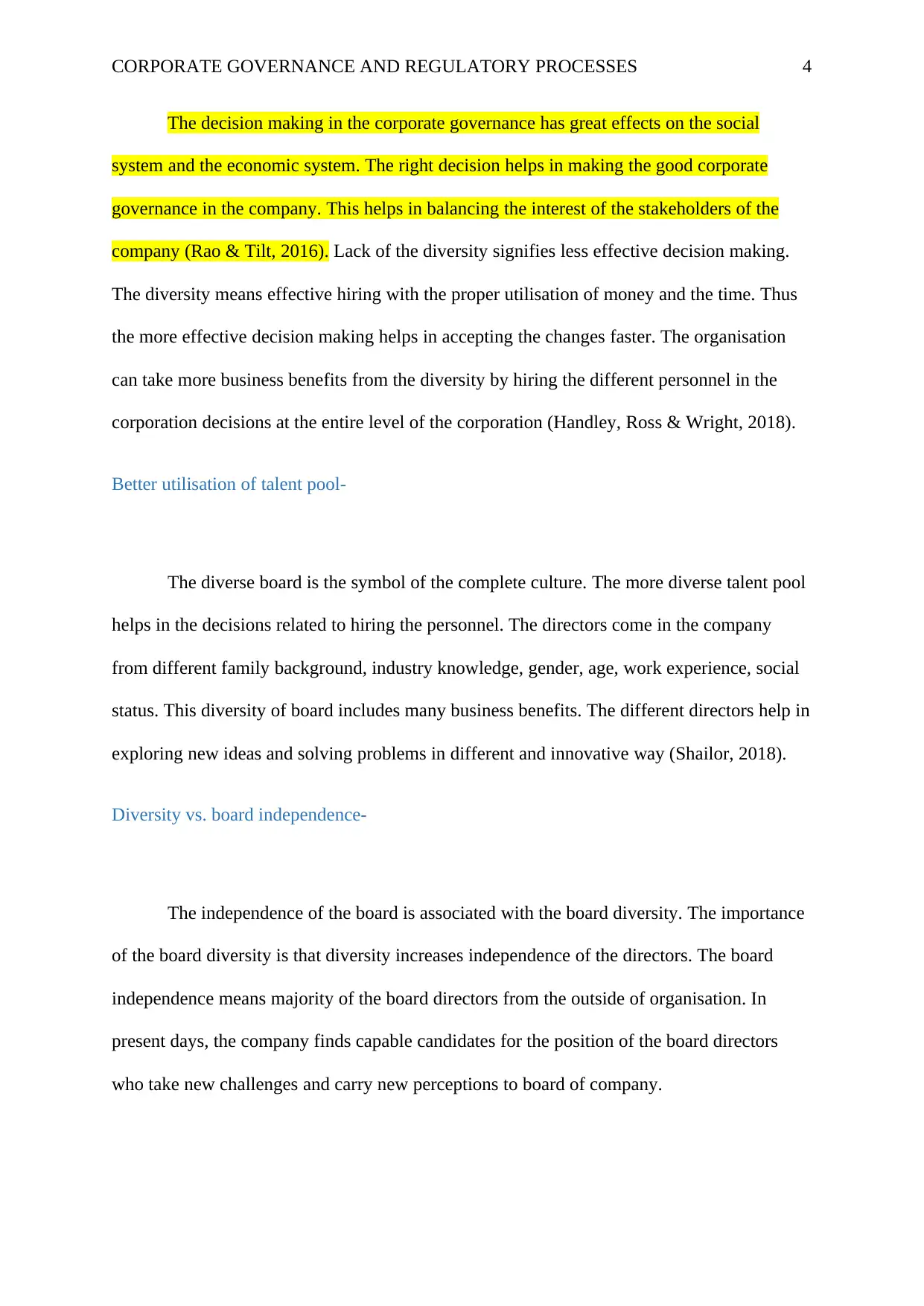
CORPORATE GOVERNANCE AND REGULATORY PROCESSES 4
The decision making in the corporate governance has great effects on the social
system and the economic system. The right decision helps in making the good corporate
governance in the company. This helps in balancing the interest of the stakeholders of the
company (Rao & Tilt, 2016). Lack of the diversity signifies less effective decision making.
The diversity means effective hiring with the proper utilisation of money and the time. Thus
the more effective decision making helps in accepting the changes faster. The organisation
can take more business benefits from the diversity by hiring the different personnel in the
corporation decisions at the entire level of the corporation (Handley, Ross & Wright, 2018).
Better utilisation of talent pool-
The diverse board is the symbol of the complete culture. The more diverse talent pool
helps in the decisions related to hiring the personnel. The directors come in the company
from different family background, industry knowledge, gender, age, work experience, social
status. This diversity of board includes many business benefits. The different directors help in
exploring new ideas and solving problems in different and innovative way (Shailor, 2018).
Diversity vs. board independence-
The independence of the board is associated with the board diversity. The importance
of the board diversity is that diversity increases independence of the directors. The board
independence means majority of the board directors from the outside of organisation. In
present days, the company finds capable candidates for the position of the board directors
who take new challenges and carry new perceptions to board of company.
The decision making in the corporate governance has great effects on the social
system and the economic system. The right decision helps in making the good corporate
governance in the company. This helps in balancing the interest of the stakeholders of the
company (Rao & Tilt, 2016). Lack of the diversity signifies less effective decision making.
The diversity means effective hiring with the proper utilisation of money and the time. Thus
the more effective decision making helps in accepting the changes faster. The organisation
can take more business benefits from the diversity by hiring the different personnel in the
corporation decisions at the entire level of the corporation (Handley, Ross & Wright, 2018).
Better utilisation of talent pool-
The diverse board is the symbol of the complete culture. The more diverse talent pool
helps in the decisions related to hiring the personnel. The directors come in the company
from different family background, industry knowledge, gender, age, work experience, social
status. This diversity of board includes many business benefits. The different directors help in
exploring new ideas and solving problems in different and innovative way (Shailor, 2018).
Diversity vs. board independence-
The independence of the board is associated with the board diversity. The importance
of the board diversity is that diversity increases independence of the directors. The board
independence means majority of the board directors from the outside of organisation. In
present days, the company finds capable candidates for the position of the board directors
who take new challenges and carry new perceptions to board of company.
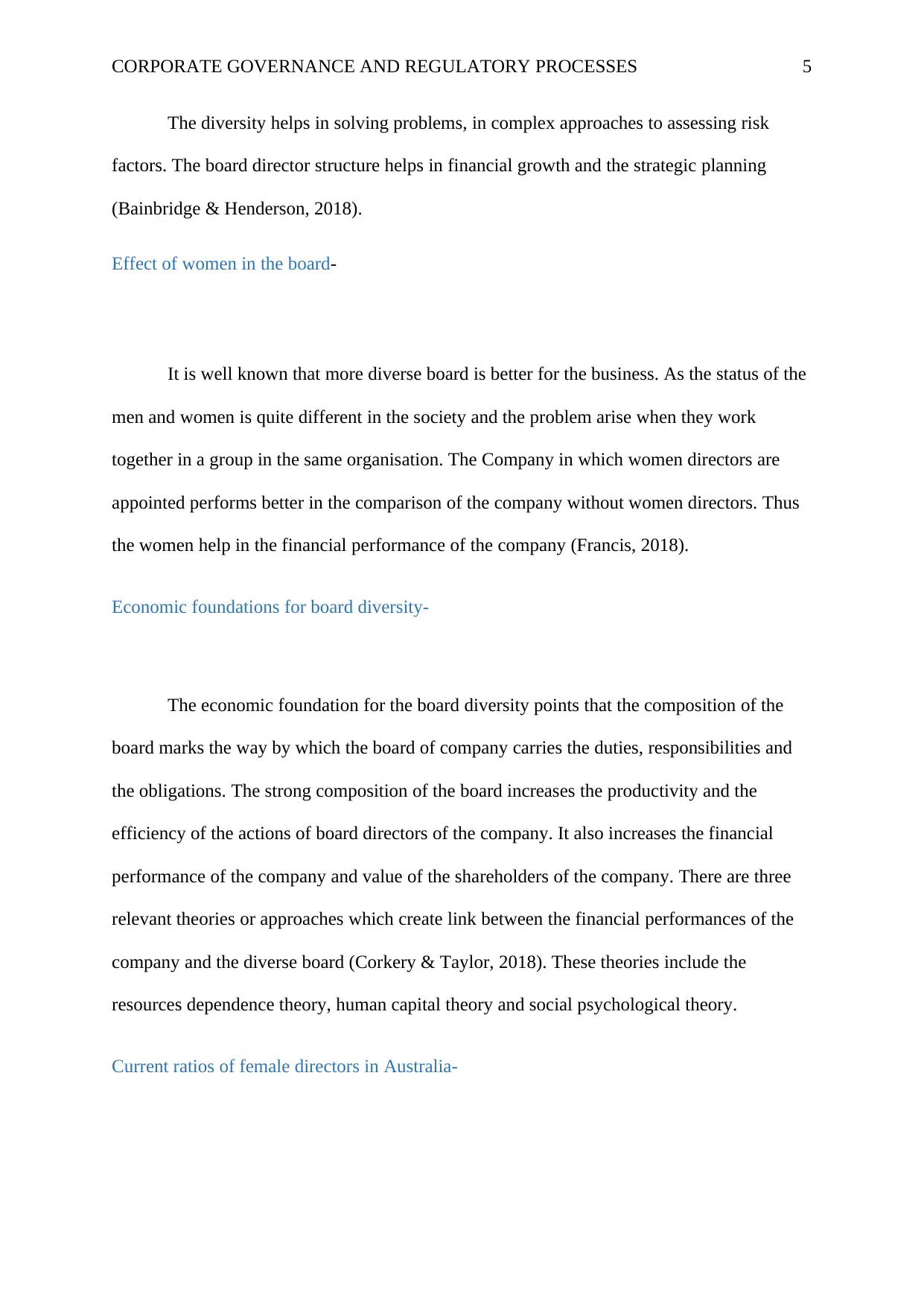
CORPORATE GOVERNANCE AND REGULATORY PROCESSES 5
The diversity helps in solving problems, in complex approaches to assessing risk
factors. The board director structure helps in financial growth and the strategic planning
(Bainbridge & Henderson, 2018).
Effect of women in the board-
It is well known that more diverse board is better for the business. As the status of the
men and women is quite different in the society and the problem arise when they work
together in a group in the same organisation. The Company in which women directors are
appointed performs better in the comparison of the company without women directors. Thus
the women help in the financial performance of the company (Francis, 2018).
Economic foundations for board diversity-
The economic foundation for the board diversity points that the composition of the
board marks the way by which the board of company carries the duties, responsibilities and
the obligations. The strong composition of the board increases the productivity and the
efficiency of the actions of board directors of the company. It also increases the financial
performance of the company and value of the shareholders of the company. There are three
relevant theories or approaches which create link between the financial performances of the
company and the diverse board (Corkery & Taylor, 2018). These theories include the
resources dependence theory, human capital theory and social psychological theory.
Current ratios of female directors in Australia-
The diversity helps in solving problems, in complex approaches to assessing risk
factors. The board director structure helps in financial growth and the strategic planning
(Bainbridge & Henderson, 2018).
Effect of women in the board-
It is well known that more diverse board is better for the business. As the status of the
men and women is quite different in the society and the problem arise when they work
together in a group in the same organisation. The Company in which women directors are
appointed performs better in the comparison of the company without women directors. Thus
the women help in the financial performance of the company (Francis, 2018).
Economic foundations for board diversity-
The economic foundation for the board diversity points that the composition of the
board marks the way by which the board of company carries the duties, responsibilities and
the obligations. The strong composition of the board increases the productivity and the
efficiency of the actions of board directors of the company. It also increases the financial
performance of the company and value of the shareholders of the company. There are three
relevant theories or approaches which create link between the financial performances of the
company and the diverse board (Corkery & Taylor, 2018). These theories include the
resources dependence theory, human capital theory and social psychological theory.
Current ratios of female directors in Australia-

CORPORATE GOVERNANCE AND REGULATORY PROCESSES 6
The number of female directors in the companies of the Australia has been increased
to support the gender diversity in the organisation of the company (Aras & Aluchna, 2018).
The Australian Institute of Company’s Directors gives the gender diversity report on the
quarterly basis. According to this report it is found that in 2018, the ratio of females in the
company is 52% of hiring to the ASX 200 boards. In 2017, it was 36% of hiring to the ASX
200 boards. In 2016, the females were 44% of hiring to the ASX 200 boards. The female’s
ratio was 34% of hiring to the ASX 200 boards in 2015. It was 30% of hiring to the ASX 200
boards in 2014. In 2013, the females were 22% of hiring to the ASX 200 boards. In 2012,
22% of hiring to the ASX 200 boards were females. The ratio of female was 28% of hiring to
the ASX 200 boards in 2011. It was 25% of hiring to the ASX 200 boards in 2010 and 5% of
hiring to the ASX 200 boards in 2009. In 2008, the ratio was 8% of hiring to the ASX 200
boards.
Australian institute of companies directors (AICD) –
The Australian Institute of company’s Directors (ACID) refers to the non-profit
membership organisation for the company’s directors. The Australian Institute of Company’s
Directors has seven state divisions and a foreign business unit. It has four national directors,
seven divisional representatives, managing director and chief executive officer.
The members of The Australian Institute of Company’s Directors (ACID) are
required to make the professional network, the professional development and the events
(Clarke, 2017). There are six types of membership such as Member Australian Institute of
Company’s Directors (MACID), Affiliate Australian Institute of Company’s Directors
(AACID), Graduate Member Australian Institute of Company’s Directors (GACID),
The number of female directors in the companies of the Australia has been increased
to support the gender diversity in the organisation of the company (Aras & Aluchna, 2018).
The Australian Institute of Company’s Directors gives the gender diversity report on the
quarterly basis. According to this report it is found that in 2018, the ratio of females in the
company is 52% of hiring to the ASX 200 boards. In 2017, it was 36% of hiring to the ASX
200 boards. In 2016, the females were 44% of hiring to the ASX 200 boards. The female’s
ratio was 34% of hiring to the ASX 200 boards in 2015. It was 30% of hiring to the ASX 200
boards in 2014. In 2013, the females were 22% of hiring to the ASX 200 boards. In 2012,
22% of hiring to the ASX 200 boards were females. The ratio of female was 28% of hiring to
the ASX 200 boards in 2011. It was 25% of hiring to the ASX 200 boards in 2010 and 5% of
hiring to the ASX 200 boards in 2009. In 2008, the ratio was 8% of hiring to the ASX 200
boards.
Australian institute of companies directors (AICD) –
The Australian Institute of company’s Directors (ACID) refers to the non-profit
membership organisation for the company’s directors. The Australian Institute of Company’s
Directors has seven state divisions and a foreign business unit. It has four national directors,
seven divisional representatives, managing director and chief executive officer.
The members of The Australian Institute of Company’s Directors (ACID) are
required to make the professional network, the professional development and the events
(Clarke, 2017). There are six types of membership such as Member Australian Institute of
Company’s Directors (MACID), Affiliate Australian Institute of Company’s Directors
(AACID), Graduate Member Australian Institute of Company’s Directors (GACID),
Paraphrase This Document
Need a fresh take? Get an instant paraphrase of this document with our AI Paraphraser
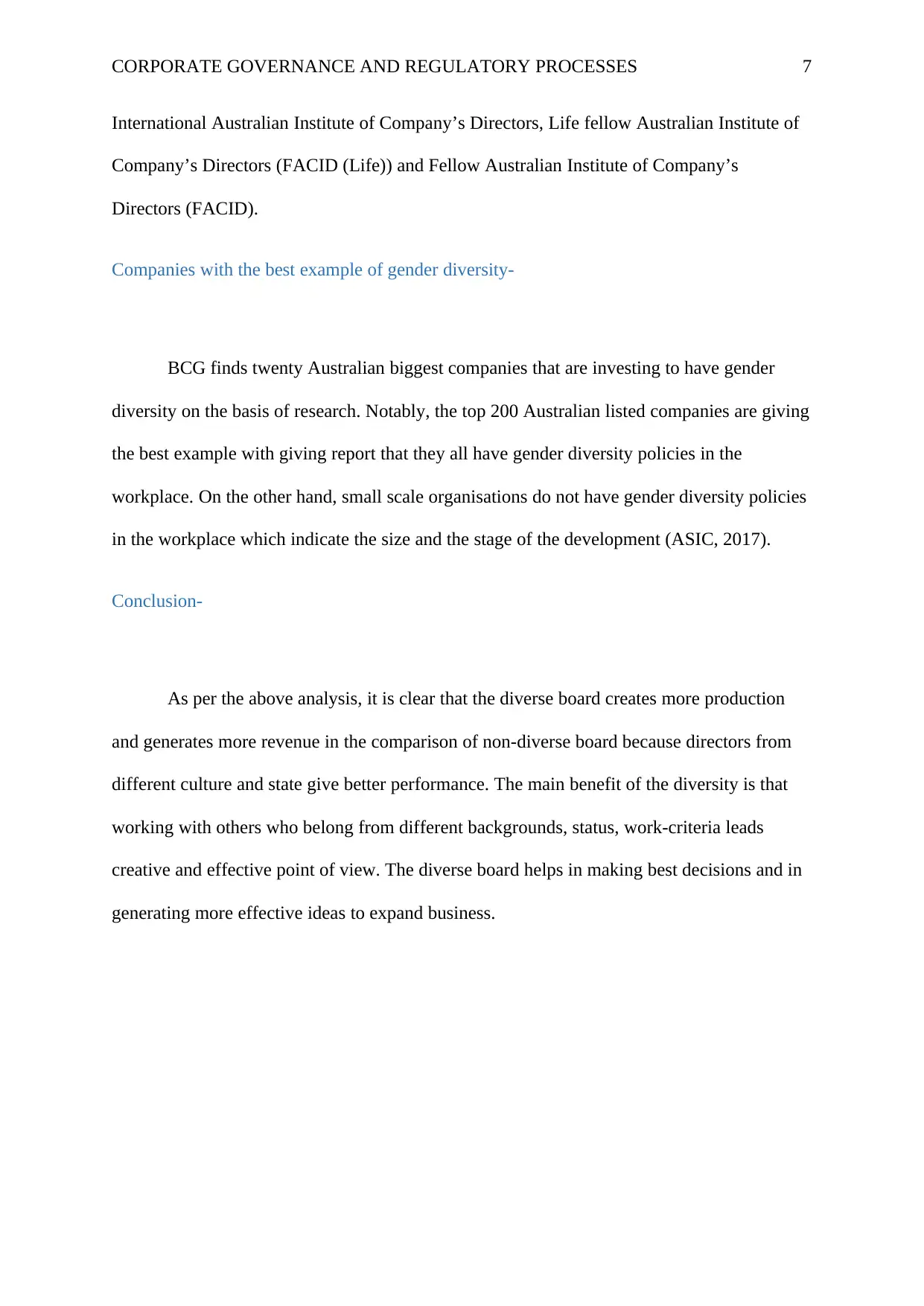
CORPORATE GOVERNANCE AND REGULATORY PROCESSES 7
International Australian Institute of Company’s Directors, Life fellow Australian Institute of
Company’s Directors (FACID (Life)) and Fellow Australian Institute of Company’s
Directors (FACID).
Companies with the best example of gender diversity-
BCG finds twenty Australian biggest companies that are investing to have gender
diversity on the basis of research. Notably, the top 200 Australian listed companies are giving
the best example with giving report that they all have gender diversity policies in the
workplace. On the other hand, small scale organisations do not have gender diversity policies
in the workplace which indicate the size and the stage of the development (ASIC, 2017).
Conclusion-
As per the above analysis, it is clear that the diverse board creates more production
and generates more revenue in the comparison of non-diverse board because directors from
different culture and state give better performance. The main benefit of the diversity is that
working with others who belong from different backgrounds, status, work-criteria leads
creative and effective point of view. The diverse board helps in making best decisions and in
generating more effective ideas to expand business.
International Australian Institute of Company’s Directors, Life fellow Australian Institute of
Company’s Directors (FACID (Life)) and Fellow Australian Institute of Company’s
Directors (FACID).
Companies with the best example of gender diversity-
BCG finds twenty Australian biggest companies that are investing to have gender
diversity on the basis of research. Notably, the top 200 Australian listed companies are giving
the best example with giving report that they all have gender diversity policies in the
workplace. On the other hand, small scale organisations do not have gender diversity policies
in the workplace which indicate the size and the stage of the development (ASIC, 2017).
Conclusion-
As per the above analysis, it is clear that the diverse board creates more production
and generates more revenue in the comparison of non-diverse board because directors from
different culture and state give better performance. The main benefit of the diversity is that
working with others who belong from different backgrounds, status, work-criteria leads
creative and effective point of view. The diverse board helps in making best decisions and in
generating more effective ideas to expand business.

CORPORATE GOVERNANCE AND REGULATORY PROCESSES 8
Reference
Aras, G., & Aluchna, M. (2018). Women on corporate board: An international perspective.
Melbourne: Pearson Education Australia Pty Ltd.
ASIC. (2017). Corporate Governance. Retrieved from; http://asic.gov.au/regulatory-
resources/corporate-governance.
Bainbridge, S. M., & Henderson, M. T. (2018). Outsourcing the board: how board service
providers can improve corporate governance. Cambridge: The Cambridge University
press.
Bottomley, S., Hall, K., Spender, P., & Nosworthy, B. (2017). Contemporary Australian
corporate law. Cambridge: The Cambridge University press.
Clarke, T. (2017). International corporate governance: A comparative Approach. Australia.
The Australia press.
Corkery, J. F., & Taylor, M. E. (2018). Gender balance in Australian boardrooms. Sydney:
Bloomsbury Publishing.
Farrar, J. H. (2017). Corporate governance in Australia. Oxford: Oxford university press.
Francis, R. D. (2018). Ethics and corporate governance. Sydney: University of New South
Wales.
Handley, K., Ross, A., & Wright, S. (2018). The same or different: how women have
included in corporate leadership in Australia. Australia: The Australia University
press.
Hussain, N., Rigoni, U., & Orji, R. P. (2018). Corporate governance and sustainability
performance: analysis of triple bottom line performance, Journal of business ethics,
149(2), 411-432.
McCahery, J.A., Sautner, Z., & Starks, L. T. (2016). Behind the scenes: The corporate
government preferences of institutional investors. The journal of finance, 71(6), 2905-
2932.
Plessis, J. J., Hargovan, A., & Bagaric, M. (2018). Principles of contemporary corporate
governance. Cambridge: The Cambridge University press.
Rao, K., & Tilt, C. (2016). Board composition and corporate social responsibility: the role of
diversity, gender, strategy and decision making. Journal of business ethics, 138(2),
327-347.
Shailor, G. (2018). Introduction to Corporate Governance in Australia. Melbourne: Pearson
Education Australia Pty Ltd.
Tricker, Bob., & Tricker, R. L. (2012). Corporate governance: principles, policies and
practices. Oxford: Oxford university press.
Reference
Aras, G., & Aluchna, M. (2018). Women on corporate board: An international perspective.
Melbourne: Pearson Education Australia Pty Ltd.
ASIC. (2017). Corporate Governance. Retrieved from; http://asic.gov.au/regulatory-
resources/corporate-governance.
Bainbridge, S. M., & Henderson, M. T. (2018). Outsourcing the board: how board service
providers can improve corporate governance. Cambridge: The Cambridge University
press.
Bottomley, S., Hall, K., Spender, P., & Nosworthy, B. (2017). Contemporary Australian
corporate law. Cambridge: The Cambridge University press.
Clarke, T. (2017). International corporate governance: A comparative Approach. Australia.
The Australia press.
Corkery, J. F., & Taylor, M. E. (2018). Gender balance in Australian boardrooms. Sydney:
Bloomsbury Publishing.
Farrar, J. H. (2017). Corporate governance in Australia. Oxford: Oxford university press.
Francis, R. D. (2018). Ethics and corporate governance. Sydney: University of New South
Wales.
Handley, K., Ross, A., & Wright, S. (2018). The same or different: how women have
included in corporate leadership in Australia. Australia: The Australia University
press.
Hussain, N., Rigoni, U., & Orji, R. P. (2018). Corporate governance and sustainability
performance: analysis of triple bottom line performance, Journal of business ethics,
149(2), 411-432.
McCahery, J.A., Sautner, Z., & Starks, L. T. (2016). Behind the scenes: The corporate
government preferences of institutional investors. The journal of finance, 71(6), 2905-
2932.
Plessis, J. J., Hargovan, A., & Bagaric, M. (2018). Principles of contemporary corporate
governance. Cambridge: The Cambridge University press.
Rao, K., & Tilt, C. (2016). Board composition and corporate social responsibility: the role of
diversity, gender, strategy and decision making. Journal of business ethics, 138(2),
327-347.
Shailor, G. (2018). Introduction to Corporate Governance in Australia. Melbourne: Pearson
Education Australia Pty Ltd.
Tricker, Bob., & Tricker, R. L. (2012). Corporate governance: principles, policies and
practices. Oxford: Oxford university press.
1 out of 9
Related Documents
Your All-in-One AI-Powered Toolkit for Academic Success.
+13062052269
info@desklib.com
Available 24*7 on WhatsApp / Email
![[object Object]](/_next/static/media/star-bottom.7253800d.svg)
Unlock your academic potential
© 2024 | Zucol Services PVT LTD | All rights reserved.





